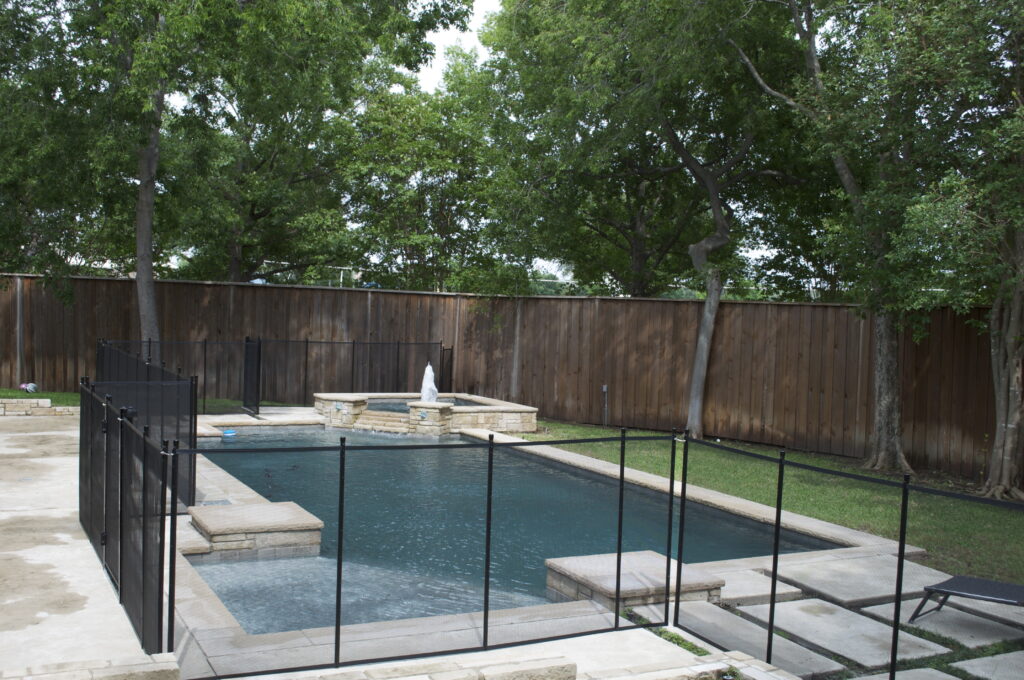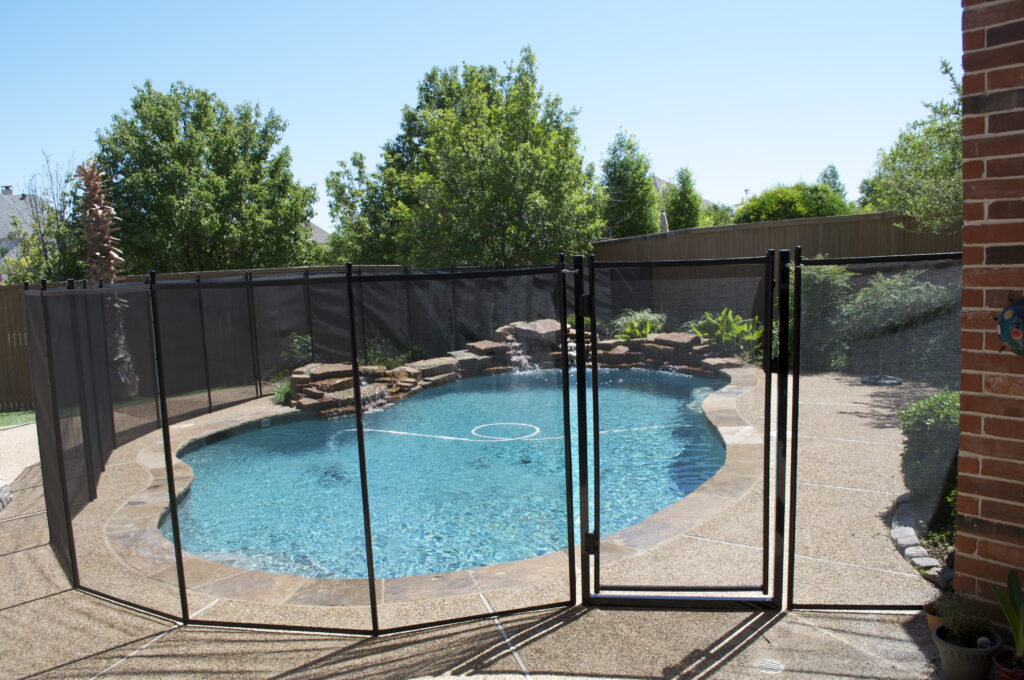Did you know that owning a pool comes with specific laws and regulations designed to ensure safety and compliance? In Texas, it is required by law to have pool safety barriers installed around the pool to ensure residents’ safety. These regulations are designed to reduce the risk of tragic accidents, especially drowning of young children, which is one of the leading causes of accidental death for children in the state.
Because we take safety very seriously, we’ve put up a list of the Texas pool fence requirements relating to pool safety barriers in the Texas area, both for the safety of your loved ones and to avoid potential legal issues.

In Texas, pool fences must meet specific safety standards. The key requirements are:
According to Texas pool fence law, all residential pools must be enclosed by a fence that is at least 48 inches tall (4 feet) measured from the ground on the side away from the pool.
As of 2025, there have been 15 drowning incidents so far. In 2024, out of 101 total drownings in Texas, 36 involved young children, primarily between the ages of 1 and 4, who drowned in backyard pools, accounting for approximately 36% of all drowning fatalities.
This height is a critical safety measure designed to prevent children from easily climbing over the barrier and gaining unauthorized access to the pool area. The minimum height requirement ensures that the fence serves as a secure and effective deterrent against accidents.
The materials used to construct your pool fence are just as important as its height. Texas pool fence requirements mandate that fences be made from non-climbable materials to effectively prevent access. Chain-link fences are prohibited for a new pool enclosure constructed after January 1, 1994, because they are easily climbable and do not provide adequate safety.
Instead, the law recommends using materials such as solid wood, metal, or mesh, as these provide a more secure barrier. Pool fence builders use these materials, which are sturdy and designed to keep children and animals from gaining access to the pool, fulfilling the primary purpose of safety and pool security.
To further enhance the security of your pool, Texas law also specifies that the fence must be gap-free. No gaps in the fence should be larger than 4 inches, which is the maximum size to prevent small children or animals from slipping through. This restriction ensures that the fence provides continuous protection around the pool area.
More precisely, if the pool barrier is constructed with horizontal and vertical members, the openings shall not allow a sphere of 1 ⅓ inches in diameter to pass through. Should the pool barrier be constructed with decorative items or cutouts, the openings of the pool fence should not be greater than 1 ¾ in any direction.
The gate must open outward away from the pool with a self-closing and self-latching device, ensuring it automatically closes and locks after every use.
The gate must have hardware enabling it to be locked by:
The latch, according to the Texas law pool fence, must be at least 60 inches above the ground, except if stated otherwise, to ensure that young children cannot reach it and accidentally open the gate. The latch may be installed lower in case the latch is installed on the pool yard and is at least three inches below the top of the gate.
A gate latch can be positioned at least 42 inches above the ground if the gate is only operable with a key, card, or combination on both sides.
The gate must also swing inward, away from the pool area, to avoid the risk of the gate being pushed open toward the pool. These simple design features make a huge difference in enhancing the security of your pool.
A door, sliding glass door, window, or French door that opens directly to the pool area may serve as a barrier if it has a:
A keyed deadbolt, keyless bolting device, sliding door pin lock, or sliding door security bar installed prior to September 1, 1993, may be placed no higher than 54 inches from the floor.
In Texas, pool safety is governed by both state law and local ordinances. Here’s a breakdown of the pool fence regulations for Dallas, Austin, Houston, and Fort Worth:
In Dallas, pool fence regulations are enforced to ensure safety and compliance with local laws. Below are the key requirements for pool fences in the city:
| Regulation | Requirement |
| Fence Height | Minimum 4 feet |
| Gate Requirements | Must be self-closing and self-latching |
| Spacing | No openings larger than 4 inches |
| Materials | Chain link is prohibited if the fence is constructed after January 1994, but latticework may be allowed with certain limitations. Mesh and solid barrier surfaces are allowed as long as they do not form handholds and footholds. |
| Additional Safety Features | Alarms on doors/windows in accordance with UL 2017, anti-entrapment covers that are ASTM F1346 compliant, where a wall or dwelling serves as a part of the barrier |
Looking for compliant pool fences in Dallas? Discover expert pool fence installation services and trusted pool fence installers in Dallas to help protect your home and loved ones today.
Austin has specific rules for pool fences that follow the Houston County pool fencing requirements, ensuring proper safety features to protect residents. Below is an outline of Austin’s pool fence regulations:
| Regulation | Requirement |
| Fence Height | Minimum 48 inches |
| Gate Requirements | Must open outward, self-closing, latch 54 inches above ground |
| Spacing | Horizontal members ≤ ¼ inch apart, vertical ≤ 1¾ inches |
| Materials | Chain link prohibited, mesh allowed, and latticework is allowed with limitations |
| Additional Safety Features | Alarms on doors/windows in accordance with UL 2017, anti-entrapment covers that are ASTM F1346 compliant, where a wall or dwelling serves as a part of the barrier |
Looking for secure and compliant pool fences in Austin? Get in touch with expert pool fence installers in Austin to enhance the safety and style of your backyard.
Houston requires specific safety features in pool fences to prevent accidents. Here are the main regulations for pool fences in Houston:
| Regulation | Requirement |
| Fence Height | Minimum 48 inches |
| Gate Requirements | Must be self-closing and self-latching |
| Spacing | No specific mention |
| Materials | Not specified |
| Additional Safety Features | Alarms on doors/windows, Anti-entrapment covers |
Besides the said regulations, each swimming pool in Houston needs to have a legible sign stating “No Swimming When Unattended.”
If you are looking for safe and secure pool fences in Houston, make sure you check and come in contact with the best pool fence installers in Houston for enhanced safety and compliance.
Failure to comply with Texas pool fence requirements can result in fines ranging from $200 to $1,000 per day. Additionally, homeowners can be held liable for accidents that occur due to non-compliance.
Yes, Texas law requires that any door or window leading to the pool area must have an alarm system that sounds when opened. The alarm helps to prevent unsupervised access to the pool area.
A permit is required to install a pool fence in Texas. Be sure to check with your local building department to ensure compliance with all local and state regulations
While it is possible to install a pool fence yourself, it is highly recommended to hire a professional to ensure that the fence complies with all regulations and safety standards.
The most recommended pool fences in Texas are made from solid materials like aluminum, wrought iron, or mesh. These materials are durable, secure, and provide an effective barrier to prevent unauthorized access.

Ensuring your pool meets Texas pool fence requirements is not only important for legal compliance but is essential for the safety of your loved ones. By adhering to the latest regulations, including height, material, and gate specifications, you can prevent accidents and avoid costly fines. Whether you’re installing a new pool or updating your existing safety measures, always make sure to consult local building departments for specific guidelines in your area.
For expert assistance in Texas pool fence installation, contact us today to ensure your pool is both safe and compliant with the latest laws. Let’s keep your family safe and your pool secure!
Please fill out the form below with your information. Your local dealer will be notified about your inquiry.
Please fill out the form below with your information. Your local dealer will be notified about your inquiry.